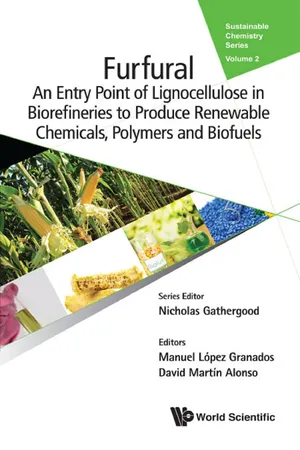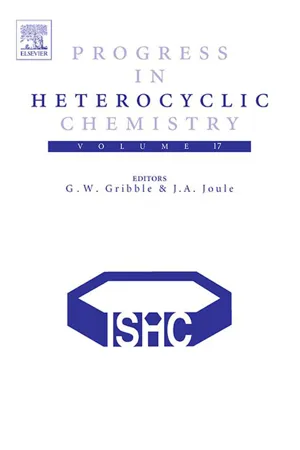Chemistry
Furan Derivatives
Furan derivatives are organic compounds that contain a furan ring in their structure. They are widely used in the synthesis of pharmaceuticals, agrochemicals, and materials. Furan derivatives exhibit a range of biological activities and are important building blocks in organic synthesis.
Written by Perlego with AI-assistance
Related key terms
Related key terms
1 of 4
Related key terms
1 of 3
3 Key excerpts on "Furan Derivatives"
- eBook - ePub
Furfural
An Entry Point of Lignocellulose in Biorefineries to Produce Renewable Chemicals, Polymers, and Biofuels
- Manuel López Granados, David Martín Alonso(Authors)
- 2018(Publication Date)
- WSPC (EUROPE)(Publisher)
3 ]).The principal physical properties of furfural and its main derivatives are shown in Table 1.1 [3 ]. The applications of products derived from furfural are multiple, Table 1.2 showing some of their main applications, as well as their synthetic route based on furfural. Further details will be given in Chapter 3 .Due to the two chemical functionalities present — aldehyde group and aromatic ring — furfural can undergo typical aldehyde reactions, such as nucleophilic additions, condensation reactions, oxidations or reductions, as well as others associated to the furan ring such as electrophilic aromatic substitution or hydrogenation.The purpose of this chapter is to give an overview of furfural chemical reactivity based on the organic chemistry fundamentals, intending to help the reader to understand the multiple possible reactions that furfural has in function of the different functionalities of the molecule: the aromatic ring and the carbonyl group.1.2.Furan and Furan Derivatives1.2.1.Furan structure, physical properties and synthesisFuran is a heterocyclic organic compound consisting of a fivemembered aromatic ring with four carbon atoms and an oxygen atom. It is a colorless, highly volatile and flammable liquid with a low-temperature boiling point (Table 1.1 ). It is slightly soluble in water but readily soluble in common organic solvents such as alcohol, ether or acetone.Table 1.2.Applications and synthetic procedure of the main furfural derivatives (adapted from Ref. [3 - eBook - ePub
- Gordon Gribble, J. Joule(Authors)
- 2005(Publication Date)
- Elsevier Science(Publisher)
Chapter 1Furans as versatile synthons for target-oriented and diversity-oriented synthesis
Dennis L. Wright [email protected] Department of Chemistry, Dartmouth College, Hanover, NH, USA1.1 INTRODUCTION
Furan, more than any other aromatic heterocycle, has found considerable application as a distinct building block for alicyclic, heterocyclic and acyclic substructures in high complexity targets. Furans are commonly found as synthons in natural product synthesis, medicinal chemistry and diversity-oriented synthesis. The focus of this review article will be on processes that lead to an overall de-aromatization of the furan with special emphasis placed on the use of furans in the synthesis of complex targets such as natural products and combinatorial libraries. The review is non-comprehensive and surveys the literature from approximately 1995. Earlier examples of these and related strategies can be found in reviews from Padwa <94PHC36 >, Vogel <90BCB395 > and Wright <01CI17 >. Synthesis and functionalization of furans are not covered but have been extensively reviewed elsewhere <82AHC167 ; 82AHC237 > .1.2 OVERVIEW OF THE CHEMISTRY OF FURAN
One of the main reasons that furan has become such an integral part of modern synthetic strategies relates to the ready availability of the parent heterocycle and many simple derivatives. Furan 1 is prepared by decarbonylation of 2-furfuraldehyde 2 which arises from acidic hydrolysis of the pentosan derivatives found in cornhusks and other agricultural products. A variety of simple furan-derived building blocks 1 -10 are offered commercially, some of which are shown below (Figure 1 ).Figure 1However, the primary reason for the versatile role of furan relates to the ease with which it is transformed to a variety of non-aromatic structures. In many instances, furan behaves in a manner analogous to other aromatic ring systems, undergoing a full range of electrophilic aromatic substitution reactions, direct metallations and even nucleophilic aromatic substitution. However, it also shows behavior typical of non-aromatic alkenes and dienes, undergoing addition reactions and cycloadditions. In comparison to the sulfur and nitrogen analogs, furan only benefits from approximately 16 kcal/mol of resonance stabilization energy, making it the least aromatic of the series. From the viewpoint of a synthetic chemist, furan can be regarded as a highly flexible and versatile four-carbon building block. Many synthetic strategies involving furan center on exploitation of its aromatic-like reactivity to easily incorporate the heterocycle into a more complex system followed by conversion to a non-aromatic moiety. An overview of the major reaction pathways (Scheme 1 - eBook - ePub
C-Furanosides
Synthesis and Stereochemistry
- Peter Goekjian, Arnaud Haudrechy, Boudjema Menhour, Claire Coiffier(Authors)
- 2017(Publication Date)
- Academic Press(Publisher)
C -furanosides also represent important platform structures for sustainable industrial chemistry.Keywords
Agro-industry (feed additives, protection of rice plants, pesticides, herbicides); Aroma and cosmetics; Asymmetric catalysis; Imaging; Perfumes; Pharmaceutical industry (anthelmintic, antibiotic, antidiabetic, antidiatom, antifungal, antihemolytic, antiinflammatory, antisense agents, antitumor, antiviral, cardiovascular, DNA amplification, enzyme inhibitors, immunomodulating, insecticidal, lysosomal diseases, monoclonal antibodies, neurodegenerative diseases, protein solubilization, vaccines); Polymers; Sulfa derivativesChapter OutlineC.1 Preparation of C -FuranosidesC.2 Agro-Industry and Farming C.2.1 Feed Additives C.2.2 Protection of Rice Plants C.2.3 Pesticides C.2.4 Herbicides C.2.5 Antifungals C.3 Ligands for Asymmetric Catalysis C.4 Perfumes, Aromas, and Cosmetics C.5 Imaging and Diagnostics C.5.1 Positron Emission Tomography C.5.2 DNA Amplification C.5.3 Diagnostic Monoclonal Antibodies C.6 Pharmaceutical Industry C.6.1 Anthelmintic Activity C.6.2 Antibiotic Activity C.6.3 Antidiabetic Activity C.6.4 Antidiatom Activity C.6.5 Antifungal Activity C.6.6 Antihemolytic Activity C.6.7 Antiinflammatory Activity C.6.8 Antisense RNA Agents C.6.9 Antitumor Activity C.6.10 Antiviral Activity C.6.11 Cardiovascular C.6.12 Enzyme Inhibitors C.6.13 Immunomodulating Activity—Autoimmune Diseases C.6.14 Insecticidal Activity C.6.15 Lysosomal Diseases C.6.16 Neurodegenerative Diseases C.6.17 Unspecified/Multiple Activities C.6.18 Nucleosides– Nucleotides C.6.19 Protein Solubilization C.6.20 Vaccines C.6.21 Vitamin D synthesis C.6.22 Sulfa Derivatives C.7 Polymers ReferencesThis section is divided into seven parts, each one dealing with a different field of application of C -furanosides. To complete the discussion of the synthesis of C -furanosides described in the preceding chapters, it is equally important to discuss the industrial results protected by patents, as well as the scientific literature pertaining to potential applications, which will be developed in this chapter. This chapter is organized by large and somewhat arbitrary domains of application, rather than by structure or stereochemistry, although we use the nomenclature set out in the general introduction. If possible, within a domain (e.g., Section C.6.9 ), the C
Index pages curate the most relevant extracts from our library of academic textbooks. They’ve been created using an in-house natural language model (NLM), each adding context and meaning to key research topics.
Explore more topic indexes
Explore more topic indexes
1 of 6
Explore more topic indexes
1 of 4


